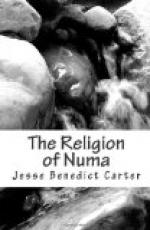But to return to the simple Hercules and the Servian regime, the Roman state had now obtained a deity, of which, by the contagion of commerce, they already felt a need, a god of great power from whom came success in the practical undertakings of life. Hence he had a strong hold on the Romans whose practical side was undergoing a rapid development. The idea of trade was now represented in the religious world, it had received its divine sanction.
The other god, who came up from Magna Graecia and whose formal acceptance into the state-cult formed one of the earliest incidents in the breakdown of the old agricultural religion, was Castor, with his twin-brother Pollux, although brother Pollux was always an insignificant partner, so much so that the temple which was subsequently built to them both was referred to either as the temple of “Castor” alone or as the temple of “the Castors.” At various points in the old Greek world we meet with a pair of brothers, at first not designated by individual names but merely named as a pair. Even these pair-names do not agree, but they represent all of them the same idea. Later when individual names are substituted for the general pair-name, these individual names also differ. They are gods of protection, and on the sea-coast—and most of Greece is sea-coast—they are especially helpful as rescuers from the dangers of the sea, and they are also very early and almost everywhere connected with horses. But in spite of their usefulness they are not very prominent, and it is doubtful whether they would ever have become famous, except for one of those little accidents which make the fortunes of gods as well as of men. It so happened that horses began to be used in warfare more than for the mere drawing of chariots; a primitive sort of cavalry came into being, produced by mounting heavy-armed foot-soldiers on horseback. With this cavalry the “Twin-Brothers” (Dios-kouroi = “Sons of Zeus"), especially Castor, became prominent. Just as the Greek merchants had taken




